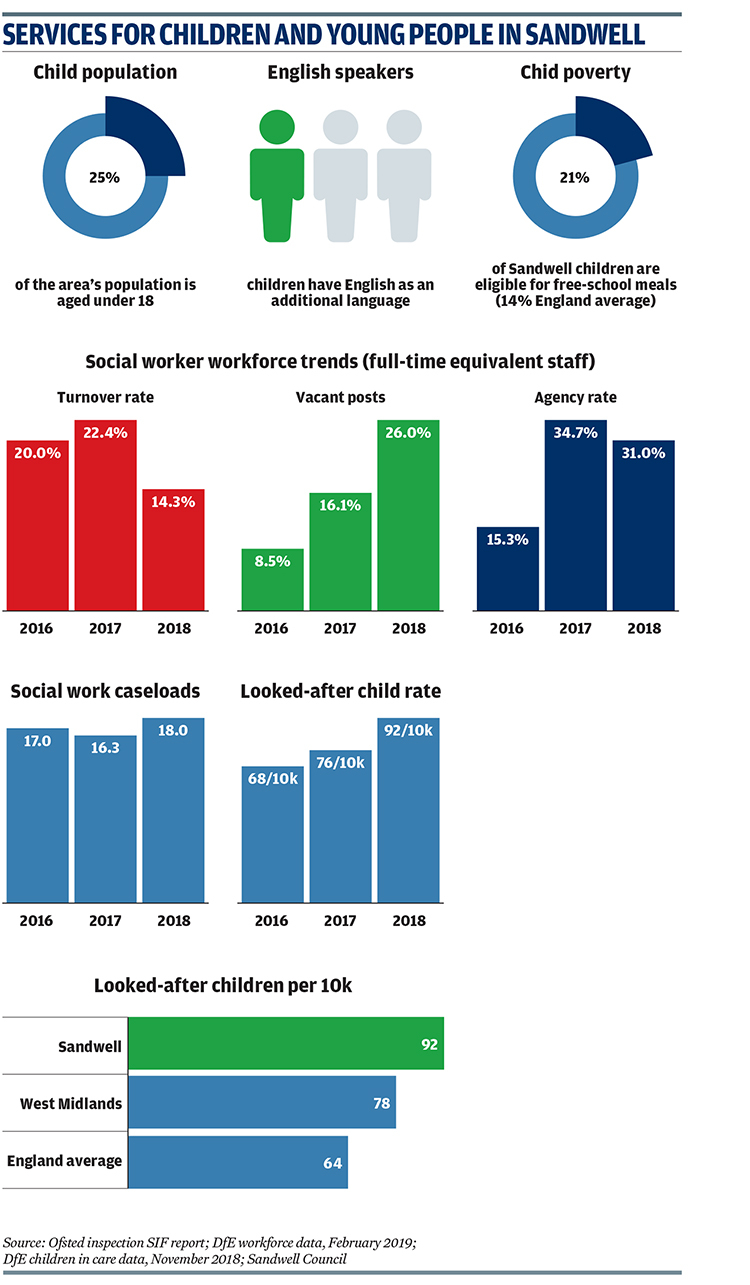Local Spotlight: Sandwell Metropolitan Borough
Derren Hayes
Tuesday, March 26, 2019
West Midlands borough has high levels of poverty and a growing child population raising pressure on new children's trust.

Sandwell is a metropolitan borough of the West Midlands region of England. The borough is named after the Sandwell Priory, which dates back to the 12th century.
According to Sandwell Metropolitan Borough Council, the borough comprises the six towns of Oldbury, Rowley Regis, Smethwick, Tipton, Wednesbury, and West Bromwich. The council head office is in Oldbury, although West Bromwich is the largest town.
Sandwell has a large and growing children and young people population. Of the 325,000 population in 2017, 21 per cent were aged under 15, three percentage points above the national average. The population grew 14 per cent between 2001 and 2017 largely thanks to a rise in international migration and rising birth rates.
Growing population
Figures from Sandwell Council show that 25 per cent of the area's population are aged under 18. This trend is predicted to continue over the next decade, with the population of 10- to 19-year-olds projected to grow by around 30 per cent by 2030.
The ethnic make up of the area has also changed significantly within a generation, with the proportion of the population identifying as of white heritage falling from 85 per cent in 1991 to 70 per cent in 2011.
Around one in three primary school children have English as an additional language, and four in 10 children in the area are from an ethnic minority group. The largest minority ethnic groups of children and young people are of Indian and Pakistani heritage.
Sandwell is the 13th most deprived out of 326 council areas in England using the Index of Multiple Deprivation, with nearly one-third of children living in poverty. According to the council, 21 per cent of school pupils are entitled to free school meals - roughly a third higher than the national average.
In October 2016, Sandwell Council was ordered to set up an independent trust to run children's social care after Ofsted rated services "inadequate" in three separate inspections between April 2013 and June 2015, and the pace of improvement was deemed not quick enough.
Independent trust
Children's services were rated inadequate again in January 2018, three months before the trust went live. It is led by former Labour Home Secretary Jacqui Smith as chair and Frances Craven as chief executive, who had previously been director of children's services in Leicester (see below). Smith has worked and lived in the West Midlands for more than 35 years and since leaving politics in 2010 has chaired University Hospitals Birmingham NHS Foundation Trust.
The most recent monitoring report, published in February, found evidence of improvement in child protection practice and the quality of leadership across the organisation. However, challenges remain around reducing reliance on agency staff and tackling rising numbers of looked-after children.

Reducing agency staff and boosting consistency of practice are key targets
By Jacqui Smith, chair, Sandwell Children's Trust
The first priority on our improvement plan was around leadership. One of the problems highlighted by Ofsted was the lack of consistent leadership, so a key priority was to get the leadership team in place. Just before Christmas we appointed Pauline Turner as director of operations, the last of our four executive director roles at the trust.
This is the first time there's been substantive leaders in place and is a vital part of our cultural development. It says that we're here for the duration and there's not going to be the churn of leaders any more. We're now looking for new heads of service and are getting good applicants coming through.
Frances Craven is a great chief executive and her experience of taking Leicester out of its inadequate rating has been invaluable.
Sandwell is an area that is big enough to be interesting but small enough for a practitioner to have an impact. We have put together a ‘12 reasons to work in Sandwell' document which covers everything from the workplace culture to our commitment to 15 days of professional development for staff.
Apart from our care management team - where we offered staff £2,500 to stabilise the workforce - we haven't used financial incentives. I'm not naïve, but I have no interest in getting into a bidding war with neighbouring authorities. Keeping people is really important - we want people who want to make a career here.
The proportion of the workforce that is agency staff is 29 per cent, which is lower than a year ago but above the target we set of 20 per cent. The agency rate compares with other councils that are in difficult circumstances.
The latest Ofsted monitoring report said we "know ourselves". We have put the foundations in place but we know this is a long slog. We have put a lot of energy and resources into addressing social work practice standards, but getting that consistency of decision making is the real long-term challenge. That's where we need to be relentless and have managers in place to monitor and support that.
The new start has helped the improvement board - chaired by Paul Moffat - to pull together partners and people have responded well to the idea that improvement is the responsibility of everybody not just the trust. For example, Frances [Craven] has worked with head teachers to look at cases that had been referred by schools and which led to no further action. It looked at why they felt they needed to refer in the first place and what alternative actions were available. These head teachers can become ambassadors for the education system about what is appropriate. We hope to do the same thing with health.
Another priority is to reduce demand in the system. We have put a lot of work into closing down cases that had been languishing, but we have seen looked-after children numbers rise from 750 to nearly 900. We need to look at whether we are making the right decisions, but frankly it is also a budget pressure.
As a board, we're looking at the 10 most expensive placements, and where children are coming from and for what reasons. We have some very good edge of care services but we think we can do more to prevent children coming into care. There are also some worrying pockets within towns where children have suffered neglect; we need to target interventions in these areas.
I'm also gobsmacked at the amount of money being paid in external placements - it's a national problem and I think we can do more to develop our own market and encouraging specialist foster carers to the trust from the private sector.




